Adopting New Technologies: E-commerce and Social Media Impact
VerifiedAdded on 2022/11/23
|9
|1982
|82
Report
AI Summary
This report provides a comprehensive analysis of the impact of new technologies, specifically e-commerce and social media, on business operations. It explores the positive effects, such as enhanced customer engagement, global market reach, and cost reduction through direct customer interaction and efficient inventory management. The report also delves into the negative impacts, including cybersecurity issues, the spread of negative publicity, high initial investment costs, and the need for skilled labor. Furthermore, the report highlights the challenges of managing brand image, the potential for customer dissatisfaction, and the importance of adapting to evolving technological landscapes. The report concludes by emphasizing the need for businesses to carefully evaluate the advantages and disadvantages of technology adoption to formulate effective strategies for sustainable growth and enhanced performance in the digital age.
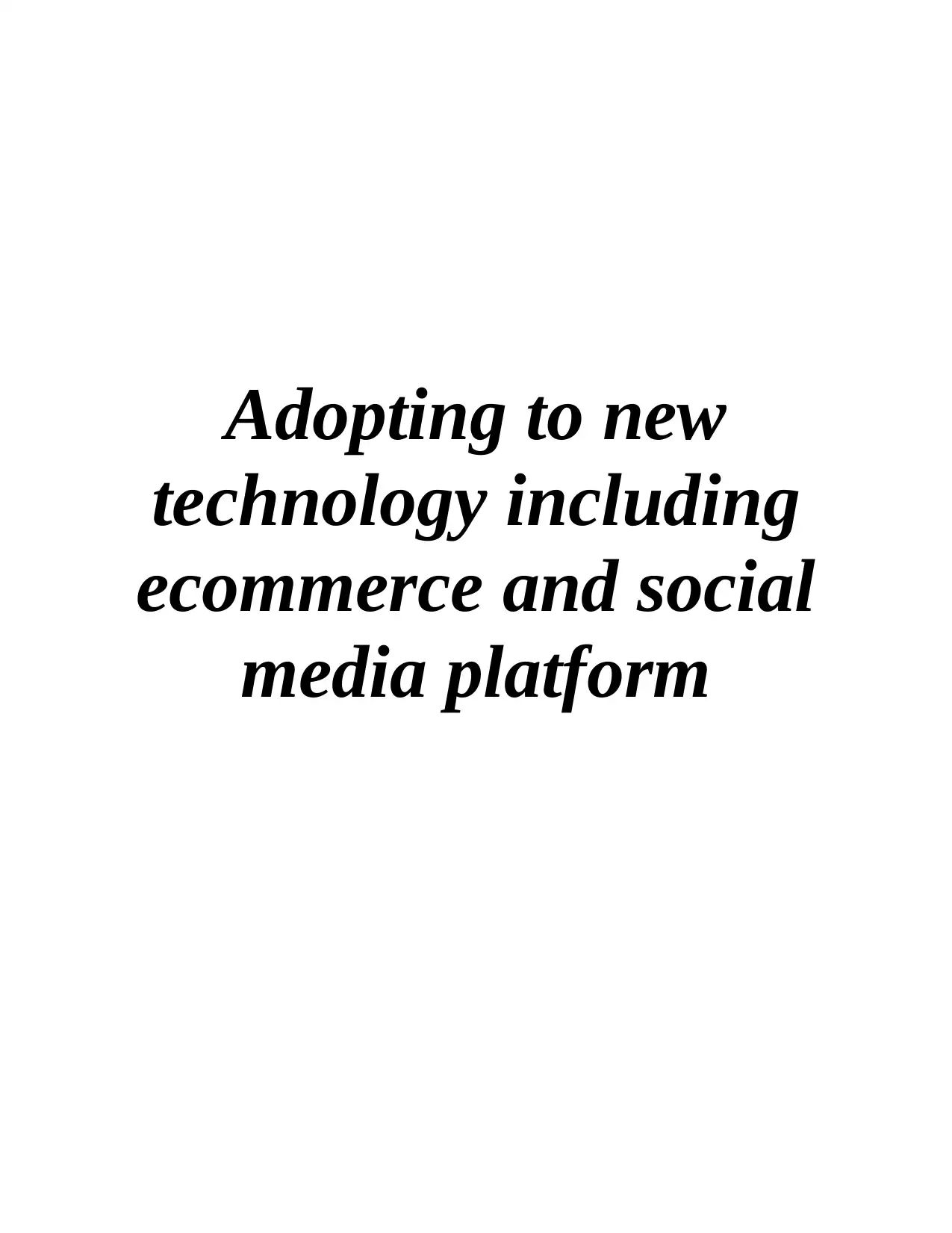
Adopting to new
technology including
ecommerce and social
media platform
technology including
ecommerce and social
media platform
Paraphrase This Document
Need a fresh take? Get an instant paraphrase of this document with our AI Paraphraser
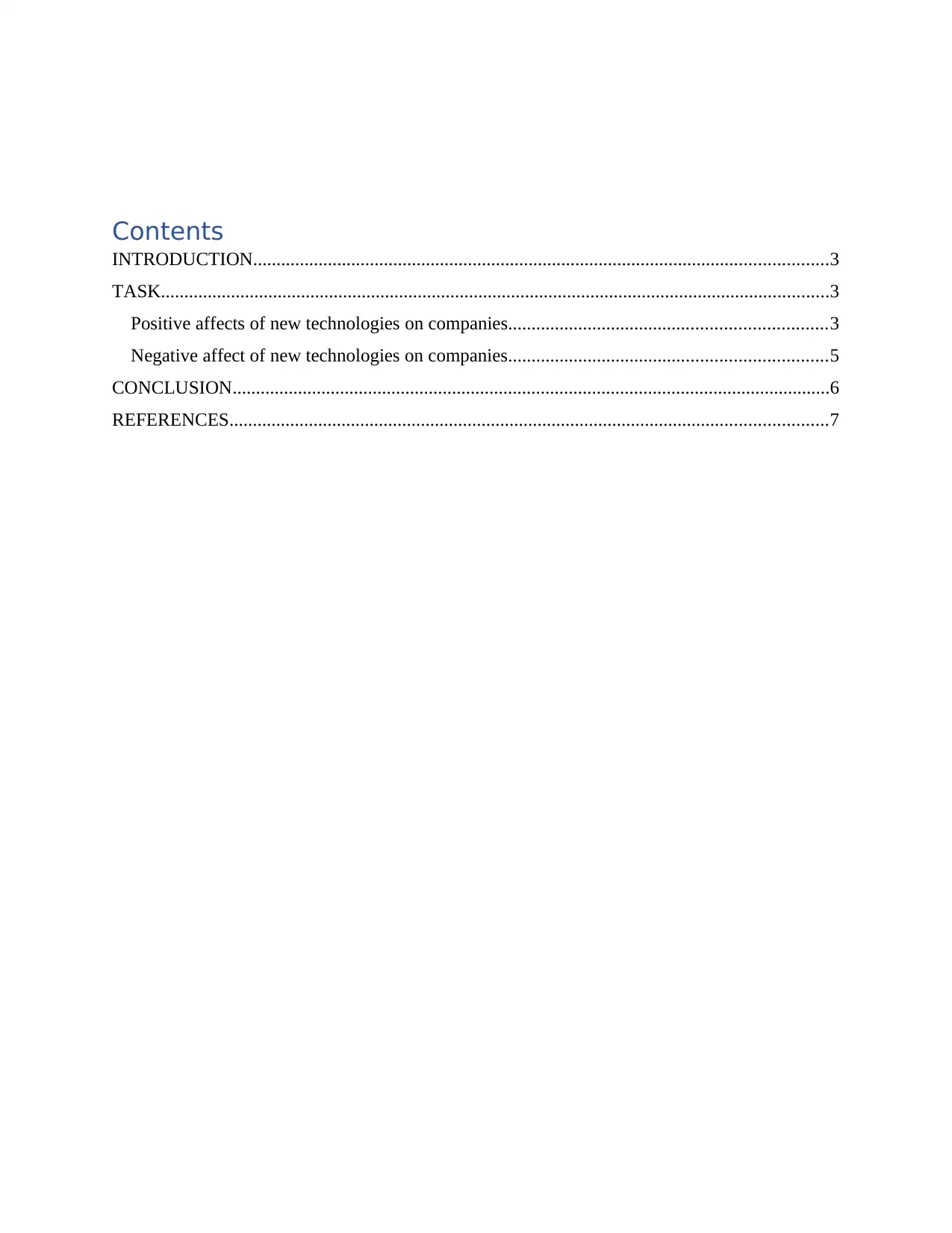
Contents
INTRODUCTION...........................................................................................................................3
TASK...............................................................................................................................................3
Positive affects of new technologies on companies....................................................................3
Negative affect of new technologies on companies....................................................................5
CONCLUSION................................................................................................................................6
REFERENCES................................................................................................................................7
INTRODUCTION...........................................................................................................................3
TASK...............................................................................................................................................3
Positive affects of new technologies on companies....................................................................3
Negative affect of new technologies on companies....................................................................5
CONCLUSION................................................................................................................................6
REFERENCES................................................................................................................................7
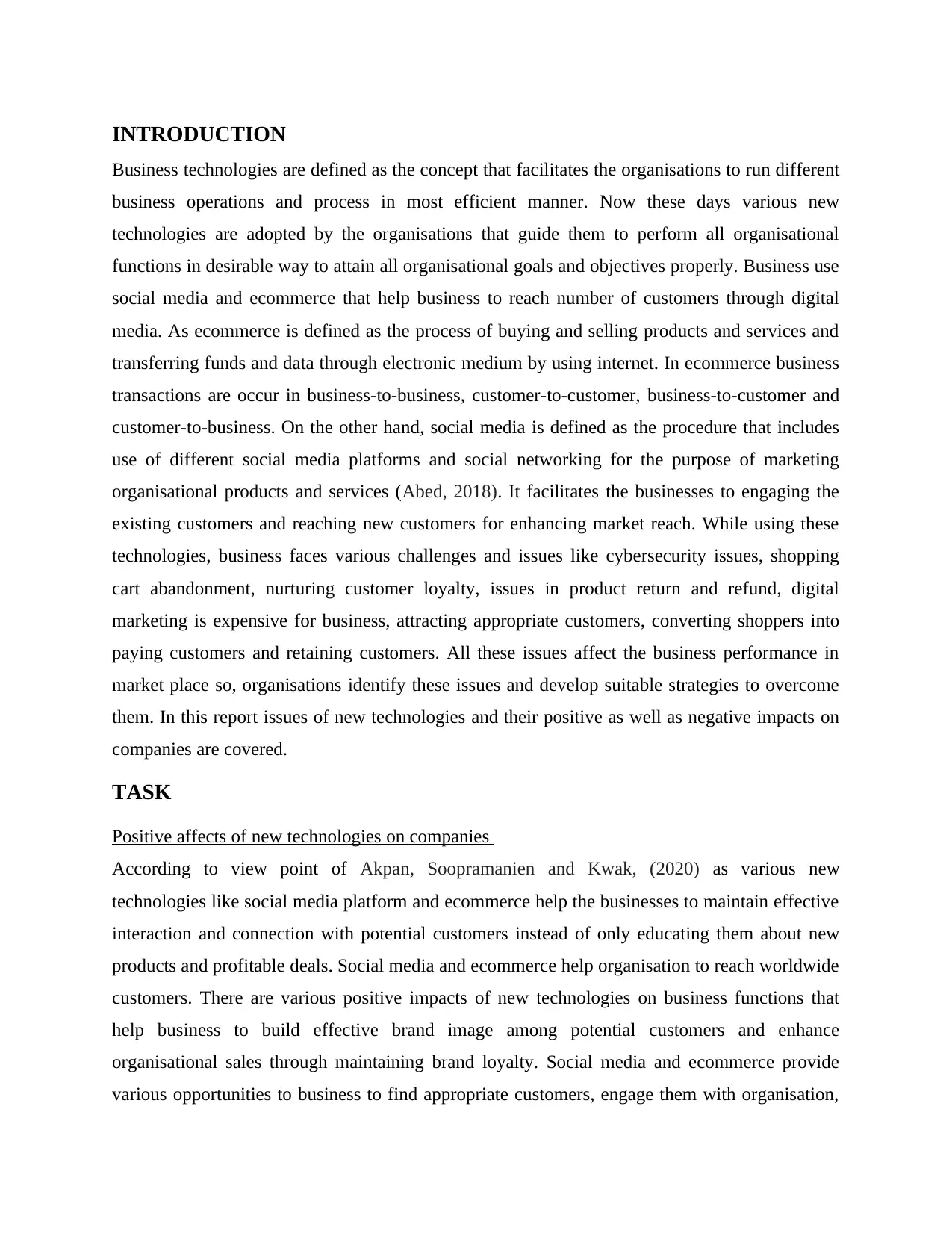
INTRODUCTION
Business technologies are defined as the concept that facilitates the organisations to run different
business operations and process in most efficient manner. Now these days various new
technologies are adopted by the organisations that guide them to perform all organisational
functions in desirable way to attain all organisational goals and objectives properly. Business use
social media and ecommerce that help business to reach number of customers through digital
media. As ecommerce is defined as the process of buying and selling products and services and
transferring funds and data through electronic medium by using internet. In ecommerce business
transactions are occur in business-to-business, customer-to-customer, business-to-customer and
customer-to-business. On the other hand, social media is defined as the procedure that includes
use of different social media platforms and social networking for the purpose of marketing
organisational products and services (Abed, 2018). It facilitates the businesses to engaging the
existing customers and reaching new customers for enhancing market reach. While using these
technologies, business faces various challenges and issues like cybersecurity issues, shopping
cart abandonment, nurturing customer loyalty, issues in product return and refund, digital
marketing is expensive for business, attracting appropriate customers, converting shoppers into
paying customers and retaining customers. All these issues affect the business performance in
market place so, organisations identify these issues and develop suitable strategies to overcome
them. In this report issues of new technologies and their positive as well as negative impacts on
companies are covered.
TASK
Positive affects of new technologies on companies
According to view point of Akpan, Soopramanien and Kwak, (2020) as various new
technologies like social media platform and ecommerce help the businesses to maintain effective
interaction and connection with potential customers instead of only educating them about new
products and profitable deals. Social media and ecommerce help organisation to reach worldwide
customers. There are various positive impacts of new technologies on business functions that
help business to build effective brand image among potential customers and enhance
organisational sales through maintaining brand loyalty. Social media and ecommerce provide
various opportunities to business to find appropriate customers, engage them with organisation,
Business technologies are defined as the concept that facilitates the organisations to run different
business operations and process in most efficient manner. Now these days various new
technologies are adopted by the organisations that guide them to perform all organisational
functions in desirable way to attain all organisational goals and objectives properly. Business use
social media and ecommerce that help business to reach number of customers through digital
media. As ecommerce is defined as the process of buying and selling products and services and
transferring funds and data through electronic medium by using internet. In ecommerce business
transactions are occur in business-to-business, customer-to-customer, business-to-customer and
customer-to-business. On the other hand, social media is defined as the procedure that includes
use of different social media platforms and social networking for the purpose of marketing
organisational products and services (Abed, 2018). It facilitates the businesses to engaging the
existing customers and reaching new customers for enhancing market reach. While using these
technologies, business faces various challenges and issues like cybersecurity issues, shopping
cart abandonment, nurturing customer loyalty, issues in product return and refund, digital
marketing is expensive for business, attracting appropriate customers, converting shoppers into
paying customers and retaining customers. All these issues affect the business performance in
market place so, organisations identify these issues and develop suitable strategies to overcome
them. In this report issues of new technologies and their positive as well as negative impacts on
companies are covered.
TASK
Positive affects of new technologies on companies
According to view point of Akpan, Soopramanien and Kwak, (2020) as various new
technologies like social media platform and ecommerce help the businesses to maintain effective
interaction and connection with potential customers instead of only educating them about new
products and profitable deals. Social media and ecommerce help organisation to reach worldwide
customers. There are various positive impacts of new technologies on business functions that
help business to build effective brand image among potential customers and enhance
organisational sales through maintaining brand loyalty. Social media and ecommerce provide
various opportunities to business to find appropriate customers, engage them with organisation,
⊘ This is a preview!⊘
Do you want full access?
Subscribe today to unlock all pages.

Trusted by 1+ million students worldwide
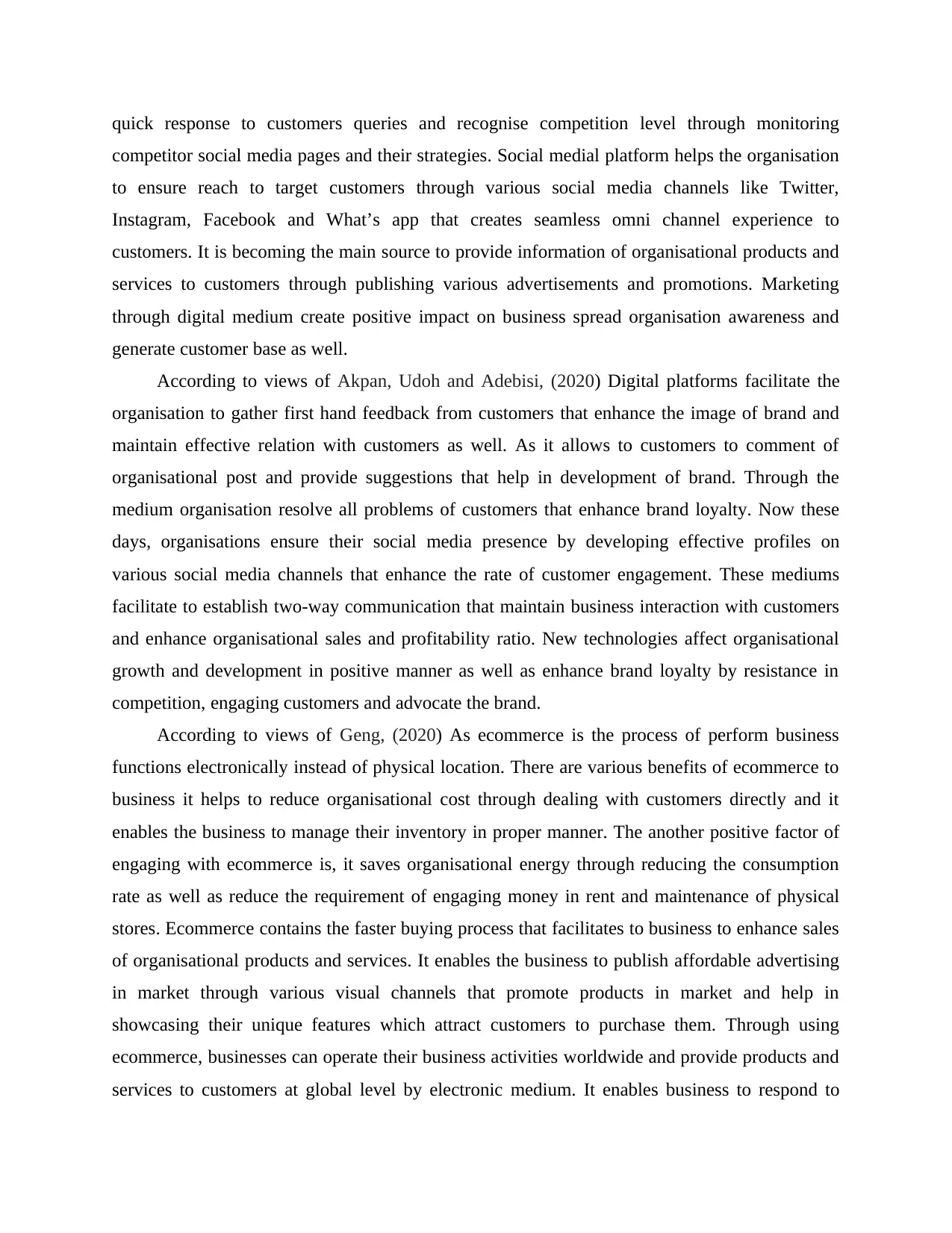
quick response to customers queries and recognise competition level through monitoring
competitor social media pages and their strategies. Social medial platform helps the organisation
to ensure reach to target customers through various social media channels like Twitter,
Instagram, Facebook and What’s app that creates seamless omni channel experience to
customers. It is becoming the main source to provide information of organisational products and
services to customers through publishing various advertisements and promotions. Marketing
through digital medium create positive impact on business spread organisation awareness and
generate customer base as well.
According to views of Akpan, Udoh and Adebisi, (2020) Digital platforms facilitate the
organisation to gather first hand feedback from customers that enhance the image of brand and
maintain effective relation with customers as well. As it allows to customers to comment of
organisational post and provide suggestions that help in development of brand. Through the
medium organisation resolve all problems of customers that enhance brand loyalty. Now these
days, organisations ensure their social media presence by developing effective profiles on
various social media channels that enhance the rate of customer engagement. These mediums
facilitate to establish two-way communication that maintain business interaction with customers
and enhance organisational sales and profitability ratio. New technologies affect organisational
growth and development in positive manner as well as enhance brand loyalty by resistance in
competition, engaging customers and advocate the brand.
According to views of Geng, (2020) As ecommerce is the process of perform business
functions electronically instead of physical location. There are various benefits of ecommerce to
business it helps to reduce organisational cost through dealing with customers directly and it
enables the business to manage their inventory in proper manner. The another positive factor of
engaging with ecommerce is, it saves organisational energy through reducing the consumption
rate as well as reduce the requirement of engaging money in rent and maintenance of physical
stores. Ecommerce contains the faster buying process that facilitates to business to enhance sales
of organisational products and services. It enables the business to publish affordable advertising
in market through various visual channels that promote products in market and help in
showcasing their unique features which attract customers to purchase them. Through using
ecommerce, businesses can operate their business activities worldwide and provide products and
services to customers at global level by electronic medium. It enables business to respond to
competitor social media pages and their strategies. Social medial platform helps the organisation
to ensure reach to target customers through various social media channels like Twitter,
Instagram, Facebook and What’s app that creates seamless omni channel experience to
customers. It is becoming the main source to provide information of organisational products and
services to customers through publishing various advertisements and promotions. Marketing
through digital medium create positive impact on business spread organisation awareness and
generate customer base as well.
According to views of Akpan, Udoh and Adebisi, (2020) Digital platforms facilitate the
organisation to gather first hand feedback from customers that enhance the image of brand and
maintain effective relation with customers as well. As it allows to customers to comment of
organisational post and provide suggestions that help in development of brand. Through the
medium organisation resolve all problems of customers that enhance brand loyalty. Now these
days, organisations ensure their social media presence by developing effective profiles on
various social media channels that enhance the rate of customer engagement. These mediums
facilitate to establish two-way communication that maintain business interaction with customers
and enhance organisational sales and profitability ratio. New technologies affect organisational
growth and development in positive manner as well as enhance brand loyalty by resistance in
competition, engaging customers and advocate the brand.
According to views of Geng, (2020) As ecommerce is the process of perform business
functions electronically instead of physical location. There are various benefits of ecommerce to
business it helps to reduce organisational cost through dealing with customers directly and it
enables the business to manage their inventory in proper manner. The another positive factor of
engaging with ecommerce is, it saves organisational energy through reducing the consumption
rate as well as reduce the requirement of engaging money in rent and maintenance of physical
stores. Ecommerce contains the faster buying process that facilitates to business to enhance sales
of organisational products and services. It enables the business to publish affordable advertising
in market through various visual channels that promote products in market and help in
showcasing their unique features which attract customers to purchase them. Through using
ecommerce, businesses can operate their business activities worldwide and provide products and
services to customers at global level by electronic medium. It enables business to respond to
Paraphrase This Document
Need a fresh take? Get an instant paraphrase of this document with our AI Paraphraser
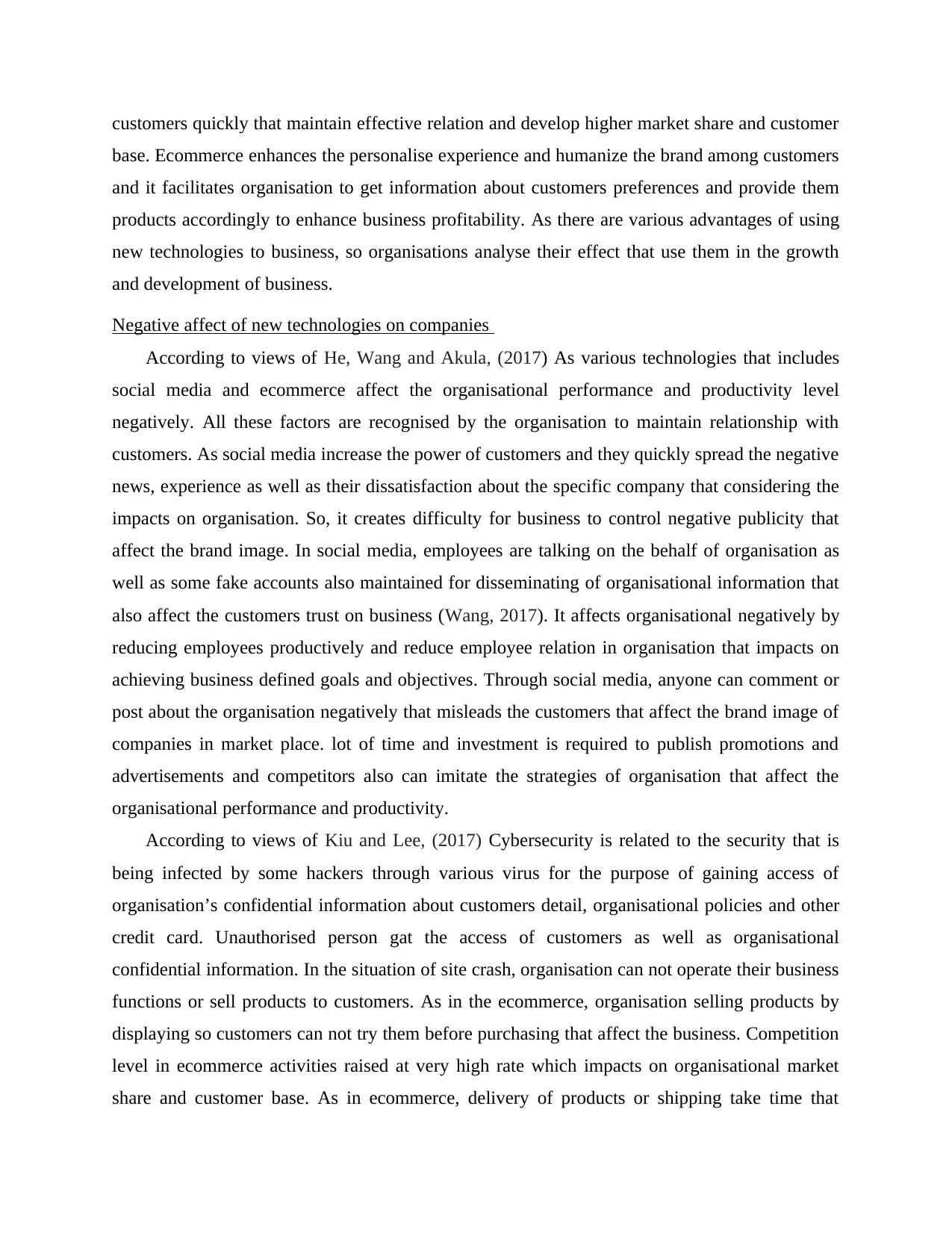
customers quickly that maintain effective relation and develop higher market share and customer
base. Ecommerce enhances the personalise experience and humanize the brand among customers
and it facilitates organisation to get information about customers preferences and provide them
products accordingly to enhance business profitability. As there are various advantages of using
new technologies to business, so organisations analyse their effect that use them in the growth
and development of business.
Negative affect of new technologies on companies
According to views of He, Wang and Akula, (2017) As various technologies that includes
social media and ecommerce affect the organisational performance and productivity level
negatively. All these factors are recognised by the organisation to maintain relationship with
customers. As social media increase the power of customers and they quickly spread the negative
news, experience as well as their dissatisfaction about the specific company that considering the
impacts on organisation. So, it creates difficulty for business to control negative publicity that
affect the brand image. In social media, employees are talking on the behalf of organisation as
well as some fake accounts also maintained for disseminating of organisational information that
also affect the customers trust on business (Wang, 2017). It affects organisational negatively by
reducing employees productively and reduce employee relation in organisation that impacts on
achieving business defined goals and objectives. Through social media, anyone can comment or
post about the organisation negatively that misleads the customers that affect the brand image of
companies in market place. lot of time and investment is required to publish promotions and
advertisements and competitors also can imitate the strategies of organisation that affect the
organisational performance and productivity.
According to views of Kiu and Lee, (2017) Cybersecurity is related to the security that is
being infected by some hackers through various virus for the purpose of gaining access of
organisation’s confidential information about customers detail, organisational policies and other
credit card. Unauthorised person gat the access of customers as well as organisational
confidential information. In the situation of site crash, organisation can not operate their business
functions or sell products to customers. As in the ecommerce, organisation selling products by
displaying so customers can not try them before purchasing that affect the business. Competition
level in ecommerce activities raised at very high rate which impacts on organisational market
share and customer base. As in ecommerce, delivery of products or shipping take time that
base. Ecommerce enhances the personalise experience and humanize the brand among customers
and it facilitates organisation to get information about customers preferences and provide them
products accordingly to enhance business profitability. As there are various advantages of using
new technologies to business, so organisations analyse their effect that use them in the growth
and development of business.
Negative affect of new technologies on companies
According to views of He, Wang and Akula, (2017) As various technologies that includes
social media and ecommerce affect the organisational performance and productivity level
negatively. All these factors are recognised by the organisation to maintain relationship with
customers. As social media increase the power of customers and they quickly spread the negative
news, experience as well as their dissatisfaction about the specific company that considering the
impacts on organisation. So, it creates difficulty for business to control negative publicity that
affect the brand image. In social media, employees are talking on the behalf of organisation as
well as some fake accounts also maintained for disseminating of organisational information that
also affect the customers trust on business (Wang, 2017). It affects organisational negatively by
reducing employees productively and reduce employee relation in organisation that impacts on
achieving business defined goals and objectives. Through social media, anyone can comment or
post about the organisation negatively that misleads the customers that affect the brand image of
companies in market place. lot of time and investment is required to publish promotions and
advertisements and competitors also can imitate the strategies of organisation that affect the
organisational performance and productivity.
According to views of Kiu and Lee, (2017) Cybersecurity is related to the security that is
being infected by some hackers through various virus for the purpose of gaining access of
organisation’s confidential information about customers detail, organisational policies and other
credit card. Unauthorised person gat the access of customers as well as organisational
confidential information. In the situation of site crash, organisation can not operate their business
functions or sell products to customers. As in the ecommerce, organisation selling products by
displaying so customers can not try them before purchasing that affect the business. Competition
level in ecommerce activities raised at very high rate which impacts on organisational market
share and customer base. As in ecommerce, delivery of products or shipping take time that
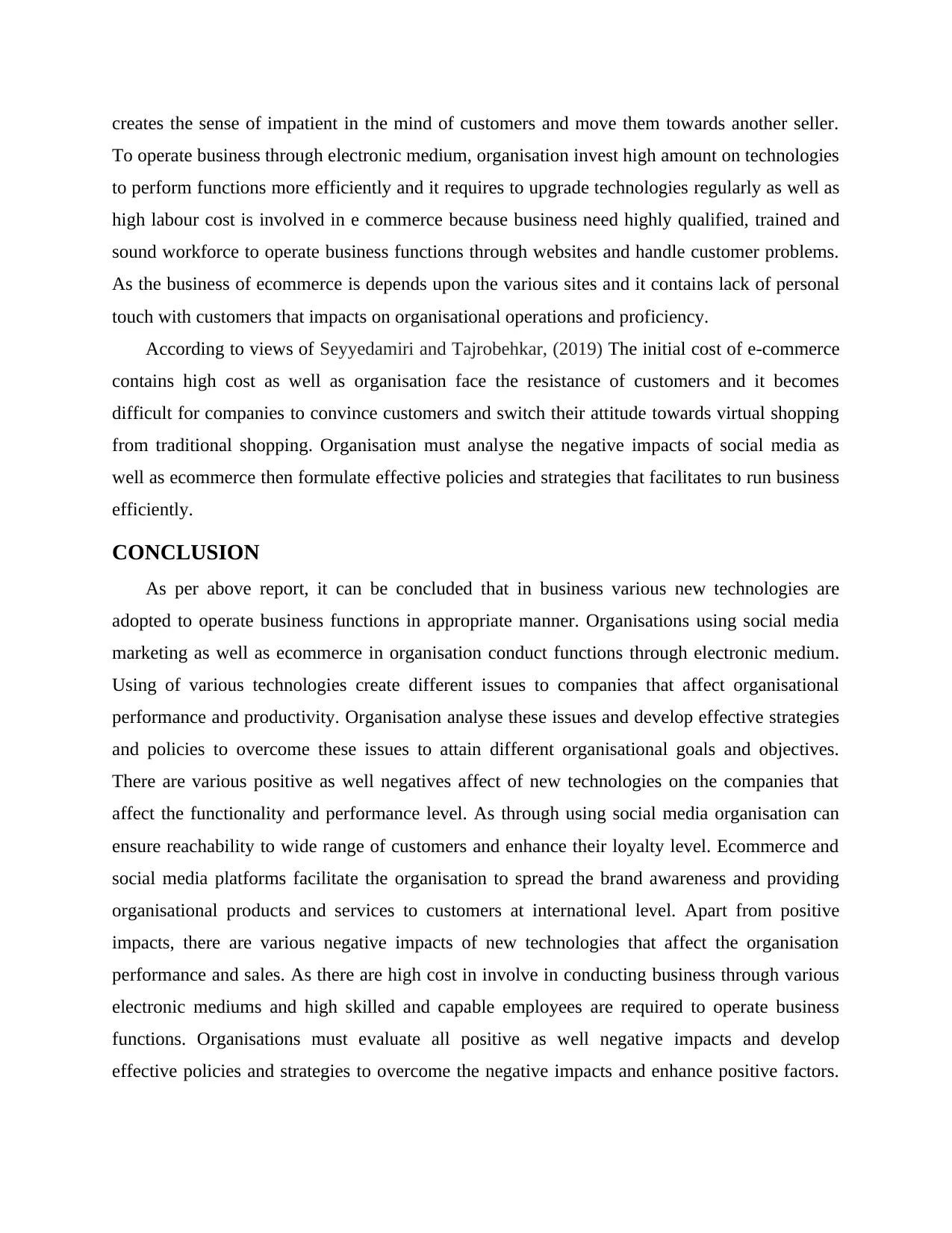
creates the sense of impatient in the mind of customers and move them towards another seller.
To operate business through electronic medium, organisation invest high amount on technologies
to perform functions more efficiently and it requires to upgrade technologies regularly as well as
high labour cost is involved in e commerce because business need highly qualified, trained and
sound workforce to operate business functions through websites and handle customer problems.
As the business of ecommerce is depends upon the various sites and it contains lack of personal
touch with customers that impacts on organisational operations and proficiency.
According to views of Seyyedamiri and Tajrobehkar, (2019) The initial cost of e-commerce
contains high cost as well as organisation face the resistance of customers and it becomes
difficult for companies to convince customers and switch their attitude towards virtual shopping
from traditional shopping. Organisation must analyse the negative impacts of social media as
well as ecommerce then formulate effective policies and strategies that facilitates to run business
efficiently.
CONCLUSION
As per above report, it can be concluded that in business various new technologies are
adopted to operate business functions in appropriate manner. Organisations using social media
marketing as well as ecommerce in organisation conduct functions through electronic medium.
Using of various technologies create different issues to companies that affect organisational
performance and productivity. Organisation analyse these issues and develop effective strategies
and policies to overcome these issues to attain different organisational goals and objectives.
There are various positive as well negatives affect of new technologies on the companies that
affect the functionality and performance level. As through using social media organisation can
ensure reachability to wide range of customers and enhance their loyalty level. Ecommerce and
social media platforms facilitate the organisation to spread the brand awareness and providing
organisational products and services to customers at international level. Apart from positive
impacts, there are various negative impacts of new technologies that affect the organisation
performance and sales. As there are high cost in involve in conducting business through various
electronic mediums and high skilled and capable employees are required to operate business
functions. Organisations must evaluate all positive as well negative impacts and develop
effective policies and strategies to overcome the negative impacts and enhance positive factors.
To operate business through electronic medium, organisation invest high amount on technologies
to perform functions more efficiently and it requires to upgrade technologies regularly as well as
high labour cost is involved in e commerce because business need highly qualified, trained and
sound workforce to operate business functions through websites and handle customer problems.
As the business of ecommerce is depends upon the various sites and it contains lack of personal
touch with customers that impacts on organisational operations and proficiency.
According to views of Seyyedamiri and Tajrobehkar, (2019) The initial cost of e-commerce
contains high cost as well as organisation face the resistance of customers and it becomes
difficult for companies to convince customers and switch their attitude towards virtual shopping
from traditional shopping. Organisation must analyse the negative impacts of social media as
well as ecommerce then formulate effective policies and strategies that facilitates to run business
efficiently.
CONCLUSION
As per above report, it can be concluded that in business various new technologies are
adopted to operate business functions in appropriate manner. Organisations using social media
marketing as well as ecommerce in organisation conduct functions through electronic medium.
Using of various technologies create different issues to companies that affect organisational
performance and productivity. Organisation analyse these issues and develop effective strategies
and policies to overcome these issues to attain different organisational goals and objectives.
There are various positive as well negatives affect of new technologies on the companies that
affect the functionality and performance level. As through using social media organisation can
ensure reachability to wide range of customers and enhance their loyalty level. Ecommerce and
social media platforms facilitate the organisation to spread the brand awareness and providing
organisational products and services to customers at international level. Apart from positive
impacts, there are various negative impacts of new technologies that affect the organisation
performance and sales. As there are high cost in involve in conducting business through various
electronic mediums and high skilled and capable employees are required to operate business
functions. Organisations must evaluate all positive as well negative impacts and develop
effective policies and strategies to overcome the negative impacts and enhance positive factors.
⊘ This is a preview!⊘
Do you want full access?
Subscribe today to unlock all pages.

Trusted by 1+ million students worldwide

As in business environment, the use of technologies are enhanced that are adopted by the
organisation to run business activities efficiently in future.
organisation to run business activities efficiently in future.
Paraphrase This Document
Need a fresh take? Get an instant paraphrase of this document with our AI Paraphraser
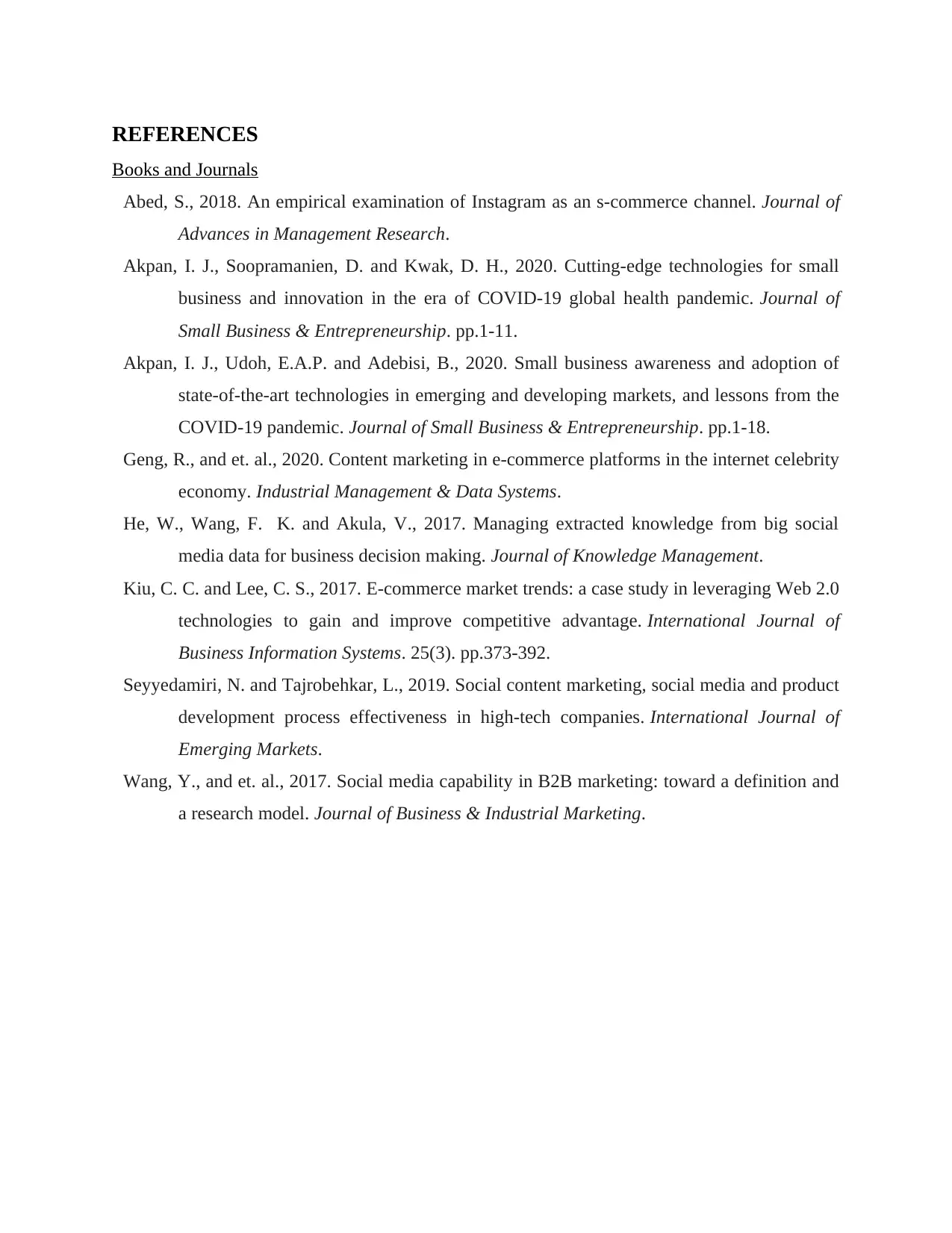
REFERENCES
Books and Journals
Abed, S., 2018. An empirical examination of Instagram as an s-commerce channel. Journal of
Advances in Management Research.
Akpan, I. J., Soopramanien, D. and Kwak, D. H., 2020. Cutting-edge technologies for small
business and innovation in the era of COVID-19 global health pandemic. Journal of
Small Business & Entrepreneurship. pp.1-11.
Akpan, I. J., Udoh, E.A.P. and Adebisi, B., 2020. Small business awareness and adoption of
state-of-the-art technologies in emerging and developing markets, and lessons from the
COVID-19 pandemic. Journal of Small Business & Entrepreneurship. pp.1-18.
Geng, R., and et. al., 2020. Content marketing in e-commerce platforms in the internet celebrity
economy. Industrial Management & Data Systems.
He, W., Wang, F. K. and Akula, V., 2017. Managing extracted knowledge from big social
media data for business decision making. Journal of Knowledge Management.
Kiu, C. C. and Lee, C. S., 2017. E-commerce market trends: a case study in leveraging Web 2.0
technologies to gain and improve competitive advantage. International Journal of
Business Information Systems. 25(3). pp.373-392.
Seyyedamiri, N. and Tajrobehkar, L., 2019. Social content marketing, social media and product
development process effectiveness in high-tech companies. International Journal of
Emerging Markets.
Wang, Y., and et. al., 2017. Social media capability in B2B marketing: toward a definition and
a research model. Journal of Business & Industrial Marketing.
Books and Journals
Abed, S., 2018. An empirical examination of Instagram as an s-commerce channel. Journal of
Advances in Management Research.
Akpan, I. J., Soopramanien, D. and Kwak, D. H., 2020. Cutting-edge technologies for small
business and innovation in the era of COVID-19 global health pandemic. Journal of
Small Business & Entrepreneurship. pp.1-11.
Akpan, I. J., Udoh, E.A.P. and Adebisi, B., 2020. Small business awareness and adoption of
state-of-the-art technologies in emerging and developing markets, and lessons from the
COVID-19 pandemic. Journal of Small Business & Entrepreneurship. pp.1-18.
Geng, R., and et. al., 2020. Content marketing in e-commerce platforms in the internet celebrity
economy. Industrial Management & Data Systems.
He, W., Wang, F. K. and Akula, V., 2017. Managing extracted knowledge from big social
media data for business decision making. Journal of Knowledge Management.
Kiu, C. C. and Lee, C. S., 2017. E-commerce market trends: a case study in leveraging Web 2.0
technologies to gain and improve competitive advantage. International Journal of
Business Information Systems. 25(3). pp.373-392.
Seyyedamiri, N. and Tajrobehkar, L., 2019. Social content marketing, social media and product
development process effectiveness in high-tech companies. International Journal of
Emerging Markets.
Wang, Y., and et. al., 2017. Social media capability in B2B marketing: toward a definition and
a research model. Journal of Business & Industrial Marketing.

⊘ This is a preview!⊘
Do you want full access?
Subscribe today to unlock all pages.

Trusted by 1+ million students worldwide
1 out of 9
Related Documents
Your All-in-One AI-Powered Toolkit for Academic Success.
+13062052269
info@desklib.com
Available 24*7 on WhatsApp / Email
![[object Object]](/_next/static/media/star-bottom.7253800d.svg)
Unlock your academic potential
Copyright © 2020–2025 A2Z Services. All Rights Reserved. Developed and managed by ZUCOL.




